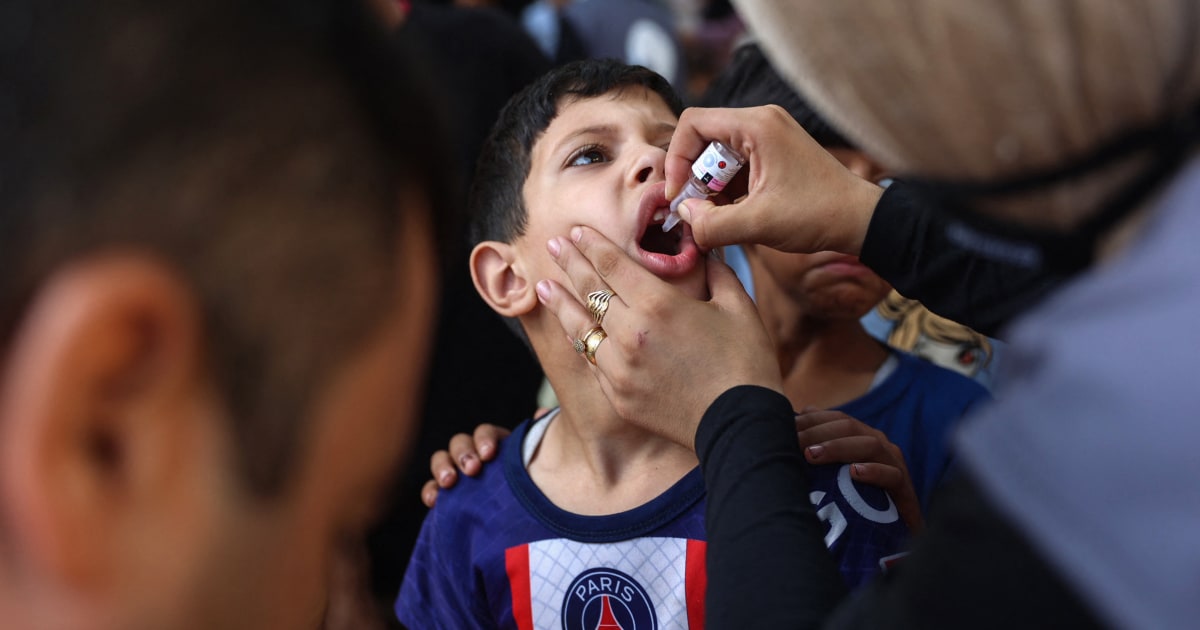
More than a half-million children in Gaza have received a first dose of the polio vaccine, the World Health Organization said Thursday.
“We reached an enormous amount of children in this short time,” Dr. Rik Peeperkorn, the WHO’s representative for the West Bank and Gaza, said during a media briefing.
So far, Peeperkorn said, 552,451 kids received the oral drops of the polio vaccine during brief moments of humanitarian pause in the conflict between Israel and Hamas in Gaza. Additional vaccines were being given on Thursday, the last day of the campaign.
While it’s impossible to maintain accurate records of every child in Gaza as most have been displaced, Peeperkorn said his team is “confident” that they were able to hit their target of vaccinating at least 90% of children under age 10.
He praised families for actively seeking out the vaccines. “Everywhere the team has gone, parents are doing all they can to ensure their child does not miss vaccination,” Peeperkorn said.
In fact, vaccination sites seemed to offer a sense of hope for Gazan families whose lives have been upended by months of war trauma and a severe lack of food, clean water and proper sanitation.
“The children came out very well-dressed,” Peeperkorn said. Many were “joyful on the streets, which hasn’t been the case for the last 11 months.”
Nongovernmental humanitarian groups participating in the vaccination efforts echoed the WHO’s sentiment.
Despite early worries that teams wouldn’t be able to reach enough children, Chessa Latifi, deputy director of emergency response for the NGO Project HOPE, said the turnout at vaccine clinics was more than the group had anticipated.
“Communities took these warnings seriously,” Latifi said. Project HOPE has vaccinated more than 2,000 against polio.
Another NGO, MedGlobal, has given approximately 5,000 doses of the polio vaccine in Gaza.
“When you’re living in tents, and you don’t have access to schools, you don’t have access to proper media, you don’t have access to clinics, and then you come out despite of the war and the threat on your lives and vaccinate,” said Dr. Zaher Sahloul, MedGlobal’s president, “it means that families really care about the health of their children and their communities.”
The massive push for vaccines began after tests found the poliovirus in wastewater samples taken from two sites in Gaza over the summer.
The strain that was found is linked to a polio vaccine that has not been used in the U.S. since 2000, but is still used in other parts of the world. That vaccine, given orally, uses a weakened but live form of the poliovirus.
Polio is extremely contagious, and is most often released into the environment through an infected person’s stool. Gaza’s plummeting sanitation situation makes the area extraordinarily vulnerable.
Concerns escalated last month when a 10-month-old baby in the Gazan city of Deir al-Balah was diagnosed with polio — an illness that causes severe muscle weakness and paralysis. It was the first recorded case of the virus in the Gaza Strip in at least 25 years.
Test results on three other children in Gaza with “acute flaccid paralysis,” which can be associated with the poliovirus, are pending.
Even if severe cases are limited to a handful, it’s likely that thousands more have been infected but don’t have symptoms.
For each case of polio, there are anywhere from 200 to 1,900 mild or asymptomatic cases, according to the Centers for Disease Control and Prevention.
A second dose of vaccine will be needed in another four weeks.
Latifi remained cautious that the efforts would continue as needed.
“There’s always a chance that these people are not going to be able to return, which then renders the vaccine much less effective,” she said. “We’re really hoping that the continued displacement is somewhat limited over the next month.”






